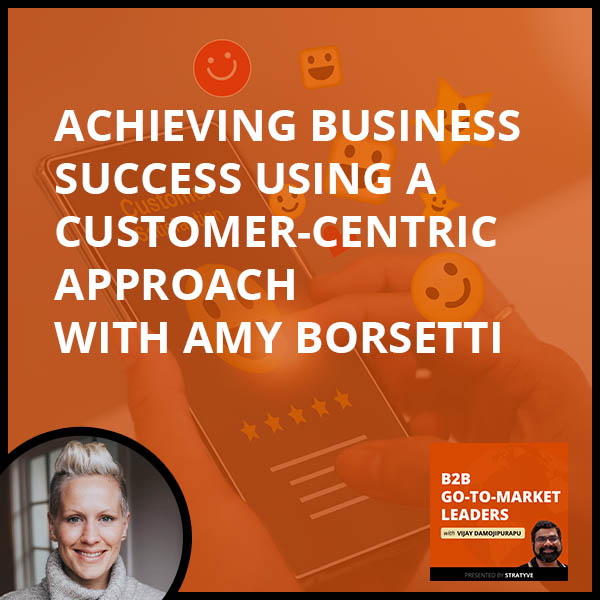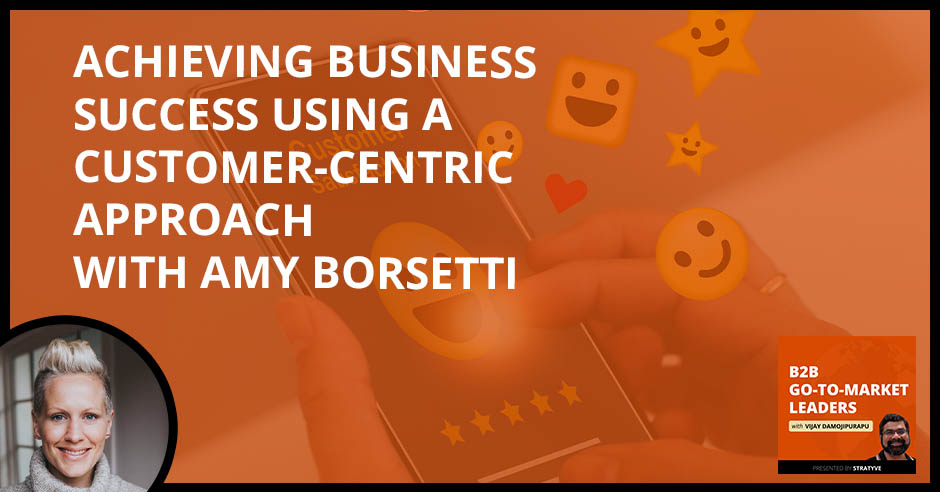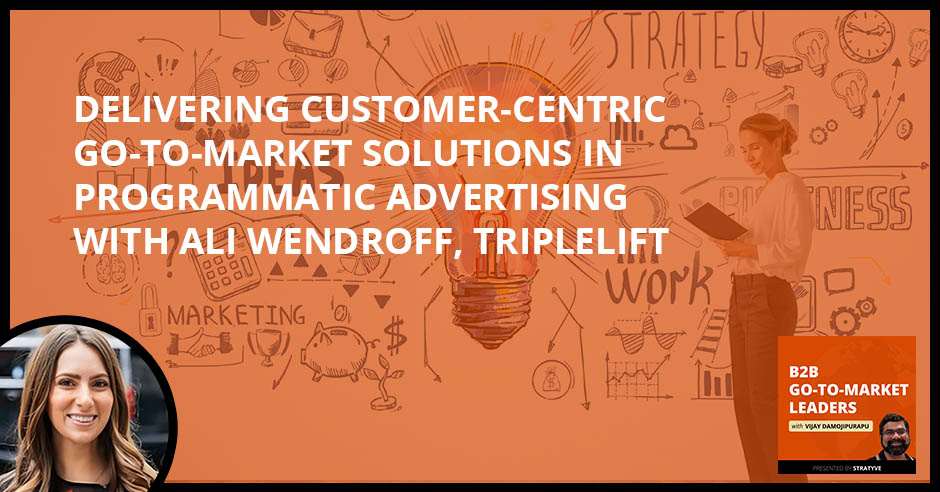

If you cannot deliver genuine value to your target market, you can never address their needs and convert them into loyal clients. For your business to succeed, implementing a customer-centric approach flawlessly is a must. Vijay Damojipurapu sits down with Amy Borsetti of Asana to share how defining their ideal customer profile and spending more time with them leads to better business strategies. She explains how they achieved go-to=market success by optimizing the customer value piece. Amy also talks about setting business goals around the needs and interests of your target audience to consistently deliver the right level of impact.
—
Listen to the podcast here
Achieving Business Success Using A Customer-Centric Approach With Amy Borsetti
I have the pleasure of hosting Amy Borsetti who is the GM of Americas at Asana. I’m pretty sure you must have heard of Asana, and we’ll talk a lot more in detail. I’m super excited to have you. Welcome to the show, Amy.
Thank you. It’s great to be here. I appreciate it.
Let’s get started with the signature question, which is how do you define and view go-to-market?
When I think about go-to-market, there are probably three lenses that I tend to look through. For any given organization, it’s how can you collectively drive as much customer value as possible based on your ICP or your Individualized Customer Profile? What you are here to put value in the hands of customers and how do you do that most effectively? There are certainly multiple teams that hold different roles in doing so.
At the center of that is the team itself. How do you rally a group of connected or disconnected individuals to be able to deliver that value? Ultimately, if you do that well, your outcome is going to be business results. Ideally, you’re looking at growth and the path to profitability, depending on where you are as an organization. You can invest more in your vision and mission, and you create that incredible virtue of cycle.
I like the way how you “simplified it.” You covered all the key aspects there, which is it always begins and ends and starts everything in the middle with the customer and what problems they’re dealing with. You also touched upon the second very important ingredient, which is the team. You have a good understanding of the customer, the ICP, but how do you bake that in, groom, guide, and nurture your team toward that ICP problem? The third is if the first two are done well, the business outcomes.
A lot of folks put the business outcomes first, but I would argue that while that can generate short-term revenue and growth, if the customer isn’t put at the center, that just has a short lifespan.
I’ve hosted over 30 guests on my show, ranging from Y Combinator founders, investors, CMO, CROs, and CPOs. Across the board, that’s a common theme. It always starts with the customer and the customer’s problems.
That’s great progress.
Let’s transition a bit. Why don’t you brief our audience about your career journey and your growth path? Clearly, you’re a sales leader, but you started not as a sales leader on day one. What was your journey like? How did you end up where you are and what you are doing now?
Thanks for asking. I have a background in human behavior. That’s where my starting point is. I got my Master’s in Behavioral Psychology many moons ago, and used to work with kids with severe behavior problems. Thinking about crossing the chasm to sales might feel a little strange, and there was certainly a lot in between. At the end of the day, I am a student and a little nerdy about why humans do what they do. That could be why they invest and buy as well as how we show up for one another.
With that, I would call it an obsession that has led me through a lot of different paths. One of which that has been helpful for the role that I am in now and even the roles I’ve been in for the last few years is after working with kids and crossing into the corporate arena, I was out there building learning programs for customers and clients in the old high-tech world, FinServe, and stuff like. That felt very similar to working with kids with different deficits that needed help. That experience of building programs to help people get better has been a transferable skillset that has pulled through even in my role now.
I spent quite a bit of time in sales. That was during my time at LinkedIn for many years, growing and building that team there. At the end of the day, my team was accountable to help the sales team be better. Going back to how we started, it was all about being able to deliver more value for our customers. Having spent quite a bit of time trying to understand how you motivate salespeople, how you ensure that you are making the right investments for them to even be able to execute your go-to-market strategy and failing a whole lot, winning some.
It was helpful as I made the move into sales itself. Usually, you find quite a few sales folks that run the path, maybe go into sales leadership, and move into sales enablement. This is perhaps different than what you might see in the market. I have found that experience and that obsession helpful to keep me grounded in what will matter most, which is if I don’t help my team be as successful as possible.
I came off a call before this one to talk about how we do this differently in 2023. I ultimately can’t deliver on the go-to-market. That journey has been a fascinating one. Here, I find myself now after spending some cycles as a formal sales leader prior to joining Asana, and now at Asana as the GM of Americas, and I formally look over our revenue teams while also spending quite a bit of my time rallying the entire AMER region. That means that I’m working very closely with customer success, marketing, certainly our sales engineering team, and many others to be able to bring a connected go-to-market strategy, including product and BDR. You name the team, we’re together trying to do the best thing for our customers. That’s a bit on the journey if that’s helpful.
You validated some of my thought processes in terms of for anyone to serve a human being. It’s funny, we had to call them out as human beings. Not many people see them as people or individuals. You need to understand the psychological aspect and what drives them, what motivates them or why they don’t act in a certain way and you happen to be the second guest on my show who majored in Psychology. The other is Ali Wendroff. I interviewed her, and she is running global sales solutions. It’s a similar path.
At the heart of it is how we create the conditions for which people can thrive ultimately. You can roll that up to how we create the conditions to be able to also help our customers thrive. With that in mind, you end up having some principles to do the right things.
I’m sure my readers want to know how you made these transitions because making the transition is not easy on what you’ve done there. Earlier, you are helping or teaching kids, and you moved into a corporate role. Before you were at Convergys, Deloitte, SweetRush, and LinkedIn, each role was different. What is your advice for people who are in a job search scenario and situation now? How to make that lateral or complete shift compared to what they were doing in their previous role?
I’m going to get a bit cerebral for a moment but it was the past few years. It wasn’t in the midst of it that I knew what I was doing with intention. At the heart of that, it is getting clarity on what’s important in your life and what you are trying to manifest, so start there every time. Sometimes you don’t know the answer, you don’t have all the answers and you don’t know perhaps what you want to do right in front of you, let alone in 5 years or 10 years.

Pushing yourself to examine this and its life first, work is a part of life. It’s no longer over here. When you take that layer and if you begin to get clarity on, perhaps it’s like, “What is the next company type? What is the next role? What is important when I think about mission and vision or whatever the list is in stack-ranked order? It’s a big forcing function. It’s wildly helpful.” When you look at your existing role, there are skillsets that you have gained that you’ve mastered or you’ve become fluent at that will serve you or not. Generally, they will, but how well will they serve you in a variety of different paths as an important reflection exercise?
For example, when I was running a sales enablement team, I knew that I was a good people leader, and I had built a set of skills that would serve me when I was leading any team. It didn’t matter if they were in sales or they were in some other type of function. I used some of my mentors and my sponsors to get critical of how well am I. How well do I do with the skillset? Where do I need improvement? How transferable is it?
People leadership is one thing. Within the realm of sales enablement, as you can imagine, I have built a set of competencies in sales but I hadn’t led a sales team. What it came down to was, “Do I understand the core metrics, the process, and the tools to be able to run the team effectively?” I knew I had some gaps and they would be overcome. I had some confidence there because I had done this other assessment on these other core skillsets. When I made the move to sales, this was a real turning point, I moved into a business where I had competency with my customer and it was differentiating.
What I mean by that is I moved into LinkedIn learning, and I had been in the world of learning, corporate learning, sales enablement, and human behavior for fifteen years prior. I had been a buyer of technology. I was learning technology for enough years to know what it meant to be on that side of the table. When I started looking for this sales role, I identified areas where I could begin adding value to my future team right away. I set up these minds of the buyer sessions with the sales team to begin to explore how I could add value before ever being in the role itself. It’s doing the job before you get the job.
You have to have a deep understanding of your competence to take that type of lead. Ran these sessions and started to get engaged in some projects because I had my eyes set on this role. When it came to the interviews and things, I already had stories about the business so I felt different. It was the first time I’d done anything like that. Reflective exercise and not only holding up the mirror yourself but having other folks holding up the mirror. For you to understand where you’re good, where you’re great, and where you have the opportunity is such a critical part of that process.
We digressed a bit but this is critical, especially given the market conditions and the situation now. Thanks for sharing your reflective exercise and how you transitioned. Coming back to the role at Asana, you are the GM of Americas. How would you define your customers? Who do you serve and how do you define the go-to-market overall?
Asana is an incredible platform and we are very fortunate to serve all types of customers across all types of industries. We’ve been successful in those areas. We have an incredible product-led growth engine where the product itself has a lot of virality to it. With that said, when we look at 2023 in particular, we’ve made some predictions, and I’m pretty bullish on this, given the market conditions, many companies beyond tech are facing new challenges and having to look at business a bit differently. Look at a way to be more profitable, efficient, scalable, and repeatable.
This year we have a material focus on elevating the role and investing in operators. We think about the role of the operator a few years ago at organizations. It feels different than the role of the operator now. These are folks that like to wake up thinking about efficiency. I have been in this mindset that all business leaders arguably need to be in for a while. We’re finding a ton of traction to help operators, help their executives and their collective teams do things better, and help their teams thrive along the way. We’re here to change the way the world works and help humanity thrive. It’s an incredible vision and we are making wild traction across the board, which is great.
Operators are people like content marketers, for example, who are trying to put the content editorial and help the executor around content strategy and execution.
That’s certainly a bullseye of ours. If you think about marketing operators that are right there with the CMO looking for ways to where we’re getting the right content, customer and time out, that’s one example. You can think about PMOs that are global and centralized ops that are working with the C-Suite or senior leadership team on establishing your annual strategy, goals, and OKRs, and helping them ensure that the work gets done. There are certainly more functional operators. Marketing ops is one example. Rev ops, product ops, and IT would be another.
Your role at Asana as GM of Americas is there. That includes the SDRs and AEs. Is that the majority of your team or do you have other supporting teams? Of course, you’ll have the ops and admins supporting those.
The way that the team is structured in 2023 is I have all of our sales segments, AEs, and AE managers as well as sales engineers in our channel function. We have globalized certain areas. I still work very closely and have a dotted-line connection to these teams in those ranges from customer success to your point to BDR, etc.
Shifting gears a bit over here. GTM or Go-To-Market is not always up and to the right. There are success stories and failure stories. If you can, share one GTM success, either from a current or previous role, and one GTM failure story.
I think that the from-to is important here. I can look at my current role. When we think about a truly integrated aligned go-to-market, we had this tremendous product-led growth and we still do. It almost created conditions where we didn’t have to be as integrated as we would aspire to be. I’m trying to ensure that you have a product-led growth engine, you overlay a sales-led growth engine, and these things are working in concert with marketing and product. We have opportunities and in 2023, we made a bold move to ensure that we like to lock ourselves in the room, figuratively and literally, to put our customers at the center and one Asana customer journey.

How the ideal experience for our customers is they begin to invest with us and invest more in the value that they should receive, the outcomes they should experience, and what it means for all of us to come together and deliver on each of those stages. We’re doing this in a very material way and it has been a tremendous way to look at how we optimize the customer value piece that I talked about at the top.
To get clarity on what the handoffs look like, how do we do this better, what is the role of our product-led growth engine, our product team, customer success, and every single team along the way? We have work to do to continue to improve this, but it’s fundamentally different than the way we were looking at go-to-market before. I’m excited to see how some of this turns out mostly in our eyes of ours.
In a nutshell, you did a deep dive into your operator journey because you’re targeting the operators. Do you have the operators for Asana? Did you dive into the operator journey across maybe the PMO, the marketing sales, and even other functions as an example?
What’s interesting about the operators, they are both buyers as they carry the purse of their executive and they’re also great mobilizers. We looked at what outcomes would we need to serve the operators as a conduit to the business. What does it look like when we do this well and don’t do it well? Being able to hold the mirror up and have some real authentic conversation, which was had on how well have we been delivering thus far. We have tremendous examples where we have been delivering off-the-charts value. There are other areas where we certainly have room for improvement. The next steps become a prioritization exercise and how we do this well.
That’s your GTM success story and obviously, that’s being played out. It’s something that gives you and your team the confidence that this will lead to success and the metrics that you’re doing.
We’ve done quite a bit of work on assessing our addressable market where we can drive even more value. How quickly from a velocity standpoint, customers have transitioned through this customer journey. We’ve already pointed out where we believe from a hypothesis perspective on where we can deliver value faster. We’ve stood up even pilot teams to start to unpack some of this. A different level of rigor around measuring whether or not we are making traction. We’re implementing an agile testing ground to ensure that our hypotheses are either tested and they’re working or they’re not and we do something different about them quickly.
That reminds me of my time when I was leading PLG at a Series B startup before. Now I’m running my GTM constantly company-serving founders and GTM leaders. Prior, while doing the PLG motion, the key there is to ensure that we have the ability to record the data and the conversions across each and every touchpoint of a free trial.
That’s number one. While we are doing that, we see where are the drop-offs happening in terms of the free trial. Is that in onboarding the different questions that we are asking? Are we asking the right questions or not? In the activation, we see them going to that product dashboard, but they’re not clicking because technically if you don’t engage the user on day 1 or day 2, you lose them.
That new user experience is critical.
On top of this, the PLG is the self-serve motion. To your point, you also have the sales-led motion. I was looking at with the head of sales in terms of how we define and map and identify the PQL and the PQA on how we do the handoffs.
It’s like the people in our meetings.
I lived there. I’ve done ELD, sales-led and marketing-led. It’s as good as living through your meetings daily. Switching gears here. What is a GTM failure story that comes to your mind?
Failure is a funny thing. Every time I hear failure, I hear feedback when done well. You can take this exact story and have to go back 2 or 3 years. Imagine what would have been possible if our go-to-market strategy was wildly connected. Asana has been making incredible progress, especially upmarket. In the enterprise, there are many wins. This exercise of identifying what we need to do to be integrated, the from that that came from is the failure. We weren’t doing it perfectly before.
We are trying to make sure that we superpower our sales-led motion by doing the right things on the product-led side and getting visibility into exactly what you’re saying with lead drop-off. Making sure our lead funnel is there and that we’re unearthing the intelligence of our platform, which is incredible. It’s to ensure that our outbound motion is meaningful to our customers and it’s through intelligence that is going to get us there. I would argue you can look at what was a failure in part, although we are successful despite ourselves. Now we’re aligning in this new way. I’m excited about where that ultimately will take us and the feedback that we have received along the way with what was to what will be.
That’s the story at Asana. How about in your previous roles, maybe at LinkedIn, something that you can share, or even other roles for that matter?
I can share a couple more broadly with prior organizations but there have been instances where the ideal customer profile has not been clearly defined. You get to a place where at the center of the go-to-market, you need to know whose problems are you solving and how specifically are you solving them. Where have you solved them in the past and how do you talk about them? We’re talking about that quite a bit here at Asana as well. I have been a part of organizations where that is not clear.
You have lots of motions. The sales team is reaching out to a number of different customer types and is broader and less specific. The narrative isn’t quite tight and aligned to an ICP and ends up being less meaningful to the masses in a market that we have where we got to get focused on profitability, efficiency, and repeatability. Our customers want that level of ROI. If the narrative isn’t there to get down to value, it’s tough for the sales team to be able to drive the type of value that we want. There have been instances in other organizations that I’ve been a part of where that clarity is not there. You end up wasting a bunch of time from a sales perspective because you’re going after anything you see versus being very targeted in your approach.
That was a great context setting there where you shared both a success story and a couple of principles or approaches of why there are GTM failures and how to rectify that. Coming back to a point that you mentioned, I was looking at your 23 predictions video. One of the things that it called out is around goal setting and how to set meaningful goals. Would you call that one of your friends?
I’m trying two different things over here, like goal setting. What are your critical GTM skills that you feel have been successful or helped you realize the success in your GTM journey? At the same time, you hit on a very important point, which is relevant to a lot of folks, GTM or not, which is goal setting and pointing down the goals.
I would say skills first at the heart of who I am as a human. I’m a deep collaborator and the heartbeat of a great go-to-market strategy is collaboration. You can’t get there without it. The concept of being able to build relationships, bring people together, get alignment on what matters most, and create a psychologically safe environment for folks to be humble, critical and have enough respect for themselves to inspect themselves.
The heartbeat of a great go-to-market strategy is collaboration. Create a psychologically safe environment for everyone to be humble, critical, and have enough self-respect to inspect themselves. Share on XThat probably is at the heart of one of my superpowers that have been meaningful here and at other organizations as well. Now when it comes to goals, to your point, this is broad, but it’s also very specific to go-to-market. As we came together as a group and we aligned on how we were going to move forward together, at the crux of that is what are our shared objectives going to be.
Where do we have dependencies and how are we going to ensure that we are making traction? It means we need to be clearer and smart about what the goals are and have a process platform insert Asana in a very deep way to be able to, in real-time, assess progress and take action quickly. The beautiful part about being at Asana is we get to leverage our platform for this stuff and we are on top of the GTM list in terms of a goals platform. That helps serve our go-to-market team in achieving the goals that we want to achieve.
The other piece of this that I imagine you’ve experienced is you have an offsite, you have something, and you set a bunch of goals or you come out of there and you set goals and everyone’s got OKRs. They then sit in some deck on some platform and they are revisited every quarter maybe. The operators are out there trying to get and gather status reporting multiple hours a week to try to roll up the right level of progress to pick your favorite executives. The whole process is manual. It’s probably not the type of work that operators even like doing. I say probably but I know this deeply with talking to our customers.
The real intelligence that allows decision-makers and business leaders to make faster decisions is making sure that your goals are intelligent. The only way you can do that is you connect the goals to the work that’s being done. There’s never been a platform to do that until Asana. There are a lot of goals and platforms and it’s the goals. You make them more automated. Maybe you make that chasing a bit easier, but they only become intelligent when they’re connected to the work.
Having a tool like Asana helps but something else that I’ve seen helps in at least making sure that you’re tracking toward a quarterly goal is to visit weekly and even on a daily basis. How do you plan your bi-weekly sprints and how do you split that into? What is my priority? That’s one exercise I did literally before I jumped on this interview with you. I did my two-week sprint planning. What are my priorities? 1, 2, 3 or 4, sequence them, and even allocate the time. A lot of people overlook the aspect of assigning time and maybe they think writing the sales forecasting report will take maybe about an hour. In reality, it takes about 2 or 3 hours and that’s a big miss.
When you think about it, you’ve got the foundational layer. You have tasks that you need to get done that are aligned to set goals. There are projects that those tasks are aligned with. There are portfolios and multiple projects of work that would ladder up to the goals of the company. If there is a disconnect there, there’s a problem with prioritization. You can get to a place where you can take the highest strategic goal of a company and you should be able to zoom it down to a task of an individual on a specific team. It should all be connected in an ideal state and that’s what we’re trying to do.
I was not planning to deep dive into goal setting to look at a video there. I thought that this is a good topic for all. Zooming out a bit, who would you give credit to and who are you grateful for in your career journey when it comes to sponsors and mentors? Who are those 1, 2, or 3 people who played a big role in your career success far?
I’ve got a couple of big standouts. I was very fortunate to work with a gentleman by the name of Mike Derezin. He’s now the COO over at Chainlink, but he was at LinkedIn with me. He’s the one that took a chance on me to bring me from sales enablement to leading enterprise, large enterprise, and strategic accounts within LinkedIn learning. How I would describe him is he’s tough, wildly analytical, and a very smart business person. He’s a true operator but what he would do in practice to help me get ramped up was profound. He would be tough in a forecast meeting, for example. Tough in that like he’s asking the questions you know you should be asking yourself before you ever get to that room or maybe you’re not.
He wouldn’t ask the question and put pressure on you in the meeting. He would certainly do. What he did after was the most profound part, which was to pull me aside and go like, “Do you understand why I’m asking you these questions?” We would be able to do quick huddles so I could learn. It wasn’t about getting pushed and trying to scramble. I was pushed and scrambling and he would teach me. He was very intentional about that process. We had a few years together, which was profound and he’s a master of change. I got to see what it looks like to have a leader that follows through, holds people accountable, and arguably not sets the standard himself but demonstrates the standard.

There were a lot of different ways that he was paramount in my learning as a leader and that never stopped. We continue to have a strong relationship. He was an incredible sponsor as I was trying to assess my next play after spending nine years at LinkedIn. He’s the guy I call when I’m working through issues now or I have thoughts or questions that I’m trying to unpack a go-to-market approach. He’s my person. He’s certainly one and there are a couple of others. I’ll let you lead the way on how deep do you want me to go in.
I love the way how you called out, where the mentor or the sponsor was tough. At the same time, ensuring that he created room for you to learn and understand the context. It’s not just pushed, but, “Go figure it out. I’m not going to give you support.” That is not the approach. That’s a critical balance. Very few leaders have that and work on that skill.
I’d never experienced it in that way until him. He’s very special and it’s been interesting to also try to emulate that. I don’t have it nailed yet in myself. It’s a story that I’ve shared with my team, myself, and others like you many times. When you can figure out that balance and carve out the time, you get so much more value out of your team, but also put value into your team, which is a thoughtful process.
Going a few years back or a decade-plus in your career journey, clearly, it didn’t come naturally to you that you’ll be successful in a sales role. You are an educator. We are working with children and something outside of you or someone gave you confidence. Is that a safe assumption?
Yes, it is safe. There was a gentleman by the name of Peter Kim, also an incredible friend of mine who I was chatting with him years ago. We were early friends about having spent much time with kids with severe behavior problems. I’m like, “I want to get into the corporate arena.” I didn’t even know what that meant. I had my Master’s in Behavioral Science, so I had done a bunch of organizational behavioral management work but it was academic.
He introduced me to a woman, Amy Haggarty, who was over at Convergys. She was in a performance consulting role working with organizations on essentially elevating their workforce that came in a variety of ways. He was like, “I’ve got this friend of mine who’s over at this company. Let me introduce you.” He was truly the conduit for me to get into the corporate arena. I did not get the job initially. I interviewed and she hooked me up with it with a number of people. I entered with getting a job in instructional design. There are people formally trained in instructional design, and I was not.
I could tell a story and connect the dots between what I was doing with kids and what I could do with adults, essentially high-functioning adults, generally speaking. Amy teased it out of me and connected me with folks at Convergys and it was about maybe three months after that when they had given me a call and said, “We’ve got headcount and it’s not specific to a specific account that they were working with. Will you come over?”
I was like, “Absolutely.” It’s my birthday too so that was memorable. It was only through relationships that I ever would’ve got in. A lot of people, to your point, are trying to get in or break through into some other industry or whatnot, the power of relationships and creating them if you don’t have them. Fortunately, you have platforms like LinkedIn where the world is much more connected professionally than it ever has been and it has in some ways leveled the playing ground. Now there’s still a privilege and all things packed into it depending on what family we were born in and how connected are they. There are certain variables to consider, it is a lot easier than it ever has been to make that.
Building relationships is much easier thanks to platforms like LinkedIn. The world is much more connected professionally than it ever has been. Share on XOne final question. I know you need to wrap up and jump to our stuff at work here. What advice would you give to your younger self if you were to remind and go back to your day one of the GTM journeys?
I didn’t always have this perspective of putting the customer value first. If I could rewind myself to the early 2000s, it was there when I was working with kids. It’s very obvious who’s most important. This transitioned to the corporate arena and all the different various jobs and companies I’ve worked at. It wasn’t until this moment where not the COO at LinkedIn, Dan Shapero, had this keynote, and he was talking about the definition of customer value. It was all about value in the eyes of the customer, not in the eyes of the business.
It was profound, and it made me rethink how I thought about go-to-market and how I thought about business in general. This paved the way for my thinking and what I get re-grounded in every time. In any decision that I make, I’m always looking at it through three lenses, team, customer, and business upside, downside, in both directions or all three directions. If I could go back and give any advice to my prior self, it would’ve been, “Put that at the center of everything you do and the good will come.” It might have put me in a different place quicker. I’m also not one to live in a ton of regret. Every moment is a moment of learning. That would be the one thing tied to go-to-market.
You touched upon a very important point there, which is when you are working with the kids, the kid is a customer. You are in touch with the customer day in and day out every single minute, every single day versus when you shift the corporate role, there’s a gap. You’re not in touch with a customer as regularly as you should be or need to be.
The more time you spend with customers, the better you become every single time. Share on XIt’s like when something is in your face. You’re deliberately working one-on-one with a child or parent so clear. In a sales role or a role like mine, if we can bring that principle to play, how much time am I spending with my customers? The more time I spend with customers, the better off I am every single time. It never fails. There’s a reason for that because they get closer to how they define value, which means I begin to get closer to how I can deliver it.
We shared a lot of insights, so thank you for your time. Good luck to you and your team.
Thank you so much, Vijay. It’s been great to spend time with you. Take care.
Important Links
Love the show? Subscribe, rate, review, and share! http://stratyve.com/





